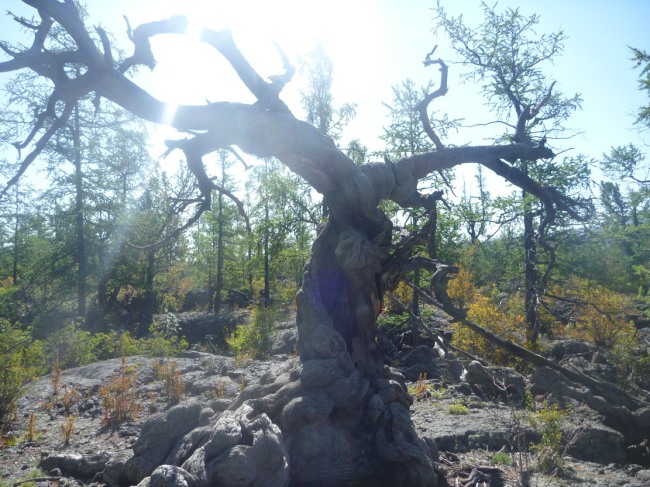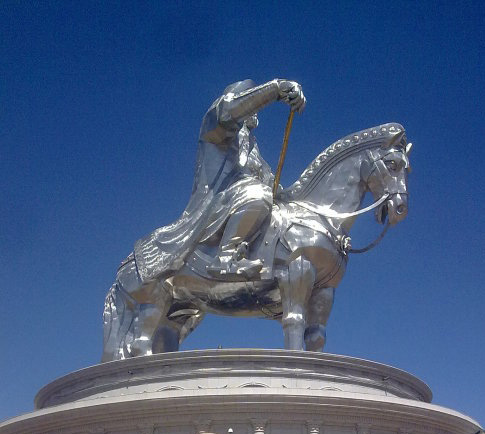We never expected this. Enkhbat had us hovering at warp speed along the Millennium Road in the northern shadows of the Khangai Mountains. Armin Van Buuren’s A State of Trance filling our rig. We were starting a new project to study the interaction between climate, fire, and forest history in the land of Chinggis Khaan and a silky voice was lifting us higher, “and if you only knew, just how much the Sun needs you, to help him light the sky, you’d be surprised. Do…do…do.do”. We were exhilarated. The Sun was shining. This was not exactly Chinggis’ steppe. But little did we know, we would eventually be chasing his ghost.
Byarbaatar & Amy in front of Khorgo, unknowingly about to meet Chinggis’s ghost. Photo credit: Enkhbat.
After about a day’s travel we started passing the Khorgo lava field. Amy asked, “What’s that?” Neil had forgotten about this landmark despite having walked upon it 10 years prior. It is a ~30 km2 lava field with old trees on it. Gordon Jacoby, Nicole Davi, Baatarbileg Nachin, and others had sampled in the early aughts and put together a ca 700 yr long drought record from Siberian larch. Neil relayed this information to Amy and she said that we should sample on it knowing that a 2,000 yr long record in the American Southwest had been produced on a similar landscape feature. We had a tight schedule, but as we drove out to the western edge of the Khangai’s, sampled sites, witnessed a sheep in the dying throes of a brain worm infection, got snowed on, and then sweated in much warmer temperatures, we decided it was worth the time to see what was out there. Little did we know.
By the time we arrived to start sampling, Neil was getting sick (we learned days later that Neil was coming down with tonsillitis) and we were on fumes from some bone-challenging swings in the weather. Amy pushed on during the first day with Byarbaatar and Balginnyam. The found a pile of dead horse bones and couldn’t get the chainsaw running stopping them from acquiring samples from downed, dead trees. It felt almost hopeless.
We summoned our strength the next day and explored a new section of the lava field. Soon after getting out there we starting seeing Siberian pine, a tree Neil hadn’t seen on his first visit and hadn’t been sampled previously at this site. We decided that after our fire history collection we would sample some pine trees just to see what They might have to say.
The Logo Tree: The Siberian pine that clued us into the possibility that there might be something extraordinary on the Khorgo lava field. Photo credit: Amy Hessl
As this collection wasn’t priority, these samples sat until late January of the following year. Here is the first email of the discovery (partially redacted for some sensitive language).
The sample “locked in and said the inner ring i measured was 1235…whoa! that was cool b/c i started a good bit from the pith…. i race back to me scope and measuring stage…..make mistakes. going too fast. fix the mistakes…..the PITH is 1142!!!!
yes, i can see the yr Chinggis was born. i can see the yr he died. i can see the yrs Mongolia rose to rule Asia!
this has been our Holy Chinggis during the entire Mongolian project.
this is totally hot censored.
neil
ps – i guess we are going back to Khorgo, huh?”
KLP0010a – the first sample of Siberian pine from the 2010 Khorgo lava collection to break the 1200s. The pith is 1142 CE (Common Era). Photo credit: Neil Pederson
We secured funding and we went back to Khorgo in 2012 with a bigger crew and one goal in mind – collect more wood.
We cannot believe what we have found.
For centuries, common wisdom held that the Mongols were driven to conquest because of harsh conditions – drought. Our new record, dating back with confidence to 900 CE (Common Era), indicates the opposite. After the unification of the Mongols, Chinggis Khan, you know him as Ghengis Khan, led his army from Northern China in 1211 to the Caspian Sea in 1224 CE. Our new record in PNAS indicates that it was consistently wet from 1211-1225, a period we are calling the Mongol Pluvial (look for an open access version of this paper here or contact Amy or me). No years during this period were below the long-term average, which is a singular rare run of moisture conditions in our 1,100 year long record. Independent tree-ring records over extra tropical Asia also indicate that this period was warm.
On the cool semi-arid steppe of Central Asia, water is life and in those days, water was energy. The Mongol diet is heavily based on the meat of grazers. Their mode of transportation was the short, but Pheidippidic horse. So, for food and for travel, grass is life. Grass is energy. An abundance of moisture would seem to provide the horsepower for the rapidly growing Mongol Empire. The Mongol soldier had five steed at their disposal. With a large army, that quickly translates into a huge herd and a huge need for grass.
Our tree-ring record suggests that the grasslands of central Mongolia were likely productive. They strongly agree with satellite estimates of grassland productivity. Going back in time, then, the trees would suggest the Mongol Empire during its rapid expansion was sitting in a sea of grass, a sea of energy, a potential abundance of life.
That is our hypothesis, anyhow, and something we will test in the coming years with historical documents, environmental records from lake sediments, more tree rings, and ecological modeling experiments.
While this record speaks to a rapid transformation of Eurasian culture during the 13th century, it also speaks about an abrupt transformation in Mongol culture today. Towards the end of our tree-ring record we see a prolonged drought from the end of the 20th century into the beginning of the 21st century. This drought followed the wettest century of the last 11 and occurred during the warmest period of the last 1,100 years in Asia. The abrupt transition in the environmental conditions, a transition that saw hundreds of lakes and wetlands disappear from the landscape, occurs during the transition from a more agriculturally-based economy to a more urban-based economy. These severe conditions, in combination with some harsh winters, killed millions of livestock and are thought to be one trigger of a mass migration of Mongols from the countryside into the capital of Ulaanbaatar.
Ulaanbaatar in 2006. The homes on the far hills likely reflect climatic and economic refugees moving from the countryside into the city. Photo credit: N. Pederson
Though we cannot connect this heat drought to climate change (though maybe we kind of can), warming temperatures have stacked the deck towards higher evaporative demand, so even if the amount of precipitation remains the same, high temperatures will generate a more intense drought. That’s what we observed in the early 21st century and based on past moisture variation in Mongolia and future predictions of warming, we would expect to see similar events in the future.
From Armin Van Buuren to Chinggis Khaan to Armin Van Buuren again. We had no clue of how Summer 2010 would light the sky.*
_____________
* this post was requested by a media outlet so they could have the ‘author’s voice’ on this discovery. That version was ultimately sanitized for your protection. Here it is unadultered.










